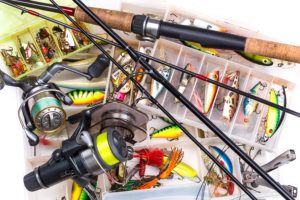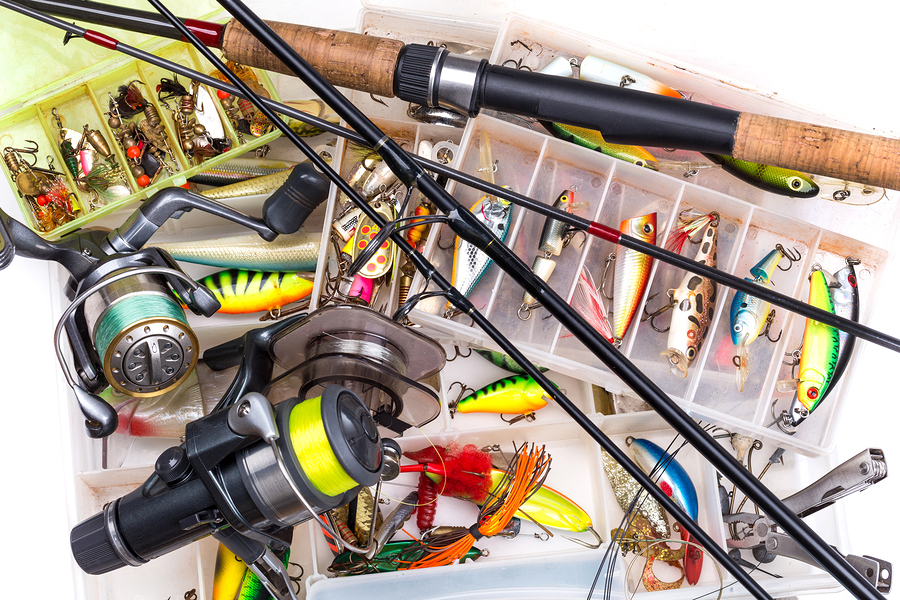Valuing Rods, Reels, Bait & Tackle
Fishing is defined as the capture of any aquatic animal, including shellfish and octopi, through the use of specialized equipment. This equipment turns up quite often in insurance claims. Over a nine-month span between January and September of 2015, Enservio processed claims of $3.8 million in fishing gear. When accurately priced, the appraised value of this gear came out to $1.8 million, a differential of $2 million.
Although the definition of fishing covers a vast array of equipment including crossbows, spears, harpoons and nets, it helps to limit the discussion to items most commonly found in claims; namely rods, reels and tackle like lures and apparel.
Types of Fishing Equipment
 Although there is some overlap in actual use, fishing equipment can be classified generally in five categories – spin casting, bait casting, saltwater, ice fishing and fly.
Although there is some overlap in actual use, fishing equipment can be classified generally in five categories – spin casting, bait casting, saltwater, ice fishing and fly.
Of these, spin casting is the easiest and the most commonly found on insurance claims. Spin casting comes in two basic styles: open and closed face. The way to distinguish the two is to inspect the reel attached on the underside of the rod. The basic equipment in these set-ups will often include items like a 5 foot or longer rod, a spinning reel, and a six to 10-pound test line for casting anywhere from 1/16 of an ounce to 3/4 of an ounce lures.
Bait casting equipment requires a little more skill to use than rods equipped with spinning reels. It is a style of fishing that relies on the weight of the lure to extend the line into the target area and involves a revolving spool reel, also known as a free spool mounting, on the topside of the rod. A bait casting setup will feature a rod with good action or flex, a quality anti-backlash reel, a 10 to 15-pound test line, and a variety of specific bait testing lures.
Saltwater fishing equipment is typically larger and more costly than its freshwater counterpart to handle larger fish. While fishermen sometimes use freshwater equipment to pursue smaller saltwater game, often it’s best to do as Captain Brody memorably advised in Jaws, “We’re gonna need a bigger boat!” and use equipment that is bigger, stronger and more durable.
In the northern regions, fishing in the winter on a frozen lake is fairly common. In its simplest form, ice fishing involves using a string and baited hook to catch fish through a hole in the ice. Ice fishing equipment can include specialized tackle, portable and permanent shelters from the cold and the use of gas powered augers for drilling through the ice.
On the other end of the fishing spectrum from this is fly fishing which, with scenes like those from the movie, A River Runs Through It, can be quite beautiful. Fly-fishing uses highly specialized rods and reels and, for this reason, is generally more expensive than traditional gear.
Fishing Rods
The most basic pieces of a fishing arsenal are a rod and reel. When discussing these items, it is important to first distinguish between a “fishing pole” and “fishing rod.” A fishing rod has guides for the line to go through which is fed through from a reel. A true fishing pole is just that – a pole or some type of stick with a line attached to the tip.
Spinning rods, as we described previously, have a reel that hangs beneath the rod. These often range in value from $15 to $100 or more. This type of fishing rod has the widest application for all types of fishing; it can be used in either fresh or salt water and for light or heavier game. For this reason it is the most popular type of rod contained in insurance claims.
Bait casting rods are typically much longer than spinning rods and usually range in value from $30 to $300 and up. Typically, these rods use heavier gauge line and are great for accurate casting over long distances.
Saltwater fishing rods can range in price from $50 to $500 and up. These rods come in a range of styles from spinning and casting models to specialty ones for surf casting and trolling lures behind boats. They typically use a heavier gauge line and the surf casting type are great for long distance, accurate casting.
Fly fishing rods range from $40 to $1000 and up. These rods are unique and immediately stand out because they are extra-long and feature extremely tiny guides for a weighted line.
Adjusters should keep in mind there are anglers who own customized poles or handmade rods that have different guides, handles, and reel seats that will affect the value. A rod’s size is an important factor in valuation but adjusters should also note the brand, the type of flex or action it has, and how many pieces it can be broken down into – two or three segments being the most common. Top fishing rod brand names include Penn, Daiwa and Shakespeare.
Fishing Reels
Spinning reels are the most popular type and most commonly found on claims because they are simple to use and versatile. The spool has excellent line capacity and can be easily swapped out with another. If you come across a claim for one of these, be sure to look for a spare spool to list as a separate line item. Spinning reels commonly range in price between $15 and $100.
Bait caster reels are easily recognized because they are positioned on the top of the rod, in contrast to spinning reels found at the bottom. It is enclosed to hold the line. Bait caster reels have a price range of $40 to $150 or more.
Although sometimes very costly, the beautiful fly reel is very simply constructed because the angler largely controls the line manually. Although commonly used for freshwater fishing, there are applications for saltwater. Fly reels range in price from $40 to $700 and up.
Saltwater reels appear much like other forms but are specifically constructed for the ocean environment. They often use aerospace aluminum for the frames and spools to prevent corrosion. Also, the components may be sealed and have waterproof bearings and drive mechanisms. Prices range from $50 for a decent quality entry, to well over $200 or more.
Fishing Tackle
Beyond fishing rods and reels, there are lures. There are many different types of these, each designed to attract a certain species of fish. Aside from live bait like worms and minnows, there are seven main types of lures: spinners, spoons, soft plastic or rubber baits, plugs, spinner baits, jigs and flies. There can be a large price variance among these types of lures. For example, rubber baits can cost as little as $5 per bag but the professional types can retail up to $50.
When dealing with lures, listing them as one large quantity in overall value may be fine but inventorying them by type, quantity, brand and size will produce a more accurate valuation.
Other fishing equipment includes hooks, weighted sinkers, tackle boxes and line. Of these, it is most important to note the type of line as these can reel in a wide price differential. A 200-pound test series of TUF-Line sells for over $400 a spool, which is far more than a spool of monofilament that would carry a price tag of $5 or less.
Apparel plays an important role in fishing and represents a good amount of contents on claims. It is important to consider waders which are essentially waterproof boots that extend to cover a fisherman’s legs, waist, and possibly the chest. The waders’ quality, the materials used and the construction of the seams determine the price.
To learn more, visit the webinar “Best Practices for Valuating Fishing Equipment” at http://www.enservio.com/fishing-equipment-on-demand-webinar-landing-page
 Chad Horlbogen is a lead trainer for Enservio (www.enservio.com), a provider of contents claim management software, payments solutions, inventory and valuation services for property insurers. Horlbogen can be reached at chorlbogen@enservio.com.
Chad Horlbogen is a lead trainer for Enservio (www.enservio.com), a provider of contents claim management software, payments solutions, inventory and valuation services for property insurers. Horlbogen can be reached at chorlbogen@enservio.com.
Was this article valuable?
Here are more articles you may enjoy.


 Munich Re: Insured Losses From Wildfires, Storms and Floods Hit Record High
Munich Re: Insured Losses From Wildfires, Storms and Floods Hit Record High  Billionaire NFL Owner Suing Over Billboards Near His SoFi Stadium
Billionaire NFL Owner Suing Over Billboards Near His SoFi Stadium  JPMorgan Wins Gender Pay Gap Dispute Against London Analyst
JPMorgan Wins Gender Pay Gap Dispute Against London Analyst  Palantir Poaching Suit Called ‘Scare’ Tactic by Ex-Employees
Palantir Poaching Suit Called ‘Scare’ Tactic by Ex-Employees 